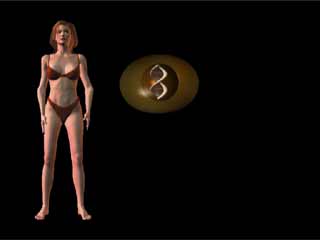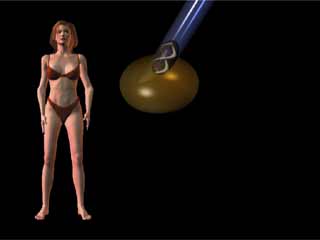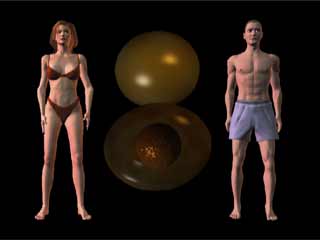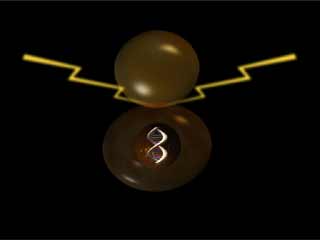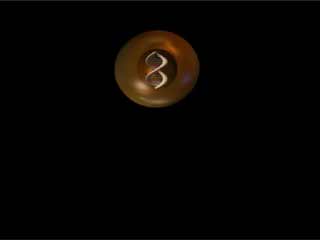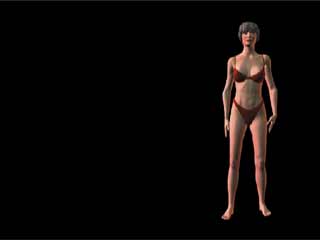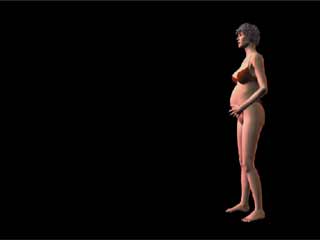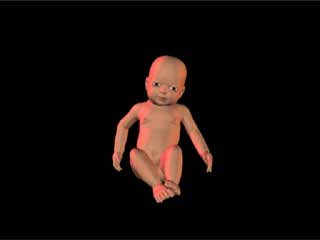HUMAN CLONING/MOVIE |
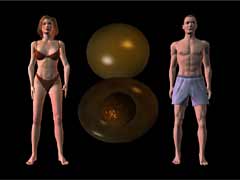
click on picture to see the movie
HUMAN CLONING/STILL IMAGES |
click on pictures to enlarge
click on pictures to enlarge
click on pictures to enlarge
animation(s) available on request on our ftp as 768x576 pixels numbered jpg files ready to be imported in an editing software such as Avid, Final Cut, After Effects, Combustion or others, or as mpg4 movie(s)
|
pricing : 3D News Graphics animations |
From
Wikipedia, the free encyclopedia
Human cloning : Currently the most successful cloning technique is the same process as which allowed Dolly the sheep to be cloned - somatic cell nuclear transfer. It is also the technique used by ACT, the first company to successfully clone a human embryo (see research section below). An egg cell taken from a donor has its nucleus removed. Another cell with the genetic material to be cloned is fused with the original cell. Another way of cloning is by parthenogenesis, where an unfertilized egg cell is induced to divide and grow as if it were fertilized. This technique could only work with females. (The technique known as embryo splitting has the potential to produce a number of genetically identical individuals, but not individuals genetically identical with a pre-existing child or adult. It is often regarded as a cloning technique, but does not meet the definition used in this article.) Purposes The likely purposes of human cloning can best be explained by referring to two kinds of cloning that would both normally use the somatic cell nuclear transfer technique. These are commonly referred to, respectively, as "reproductive cloning" and "therapeutic cloning". In reproductive cloning, the cloned embryo is implanted in a woman's uterus. This should develop into a normal baby, its only distinction being that it would be almost genetically identical to the DNA donor. Scientific knowledge of normal and abnormal development could also be found. Therapeutic cloning could be used to provide replacement organs or tissue for people who have had theirs damaged. The cloned embryo would contain DNA taken from the transplant patient. After nuclear transfer, the cell would divide to form an embryo and stem cells would be removed. Stem cells could develop into any tissue or organ. These cloned organs would be compatible with the person's immune system, so no immunosuppressant drugs would have to be taken after the operation. However, no therapies have been developed yet from this procedure. [edit] Limits of cloning First, none of these techniques provide exact clones — they would be 99.7% identical to the DNA donor, because some important genes are present outside the nucleus, in mitochondria for example. Some of the DNA of the DNA donor would be missing for the clone to be an exact copy, and some of the resulting clone DNA would come from the donor egg-cell. How much change this would lead to in the clone is being investigated. Consider that the chimpanzee genome is more than 98% identical to the human genome, only a 2% difference. A 0.3% difference could potentially lead to much more divergence from the DNA donor's genotype than one may at first believe. It could also spell problems for therapeutic cloning, where compatibility is essential because of the risk of rejection. Second, difficulties with cloning organisms from their somatic (non germline) cells tend to lead to (what seems to be) premature aging in higher animals. If a new brain is generated in that body, there is no reason to believe that consciousness, apart from the ethics of the move, can ever be moved from one brain into a new brain even if it is genetically identical. Identical twins often show uncanny parallels in life choices, but rarely do they exhibit any characteristics that would cause one to believe that genetic similarities in brains lead to any kind of compatibility of consciousness. If a brain is moved from an old body to a new one, even a clone, it would continue to lose size and capacity to regenerate cells, and continue to be subject to such degenerative disorders as Alzheimer's disease. Given all this, "immortality" seems a difficult goal to achieve, and even extended lifespan may be at a low quality of life. Given these limits, the main reason for interest in the speculations is that they may be driving funding for research, and providing active lobbying for legal or political protections for the cloning industry. Concerns regarding the Raelian movement tend to focus on these issues. All such issues are likely to be solved with better manipulation of DNA (better copies, able to fix changes which occur with each cell division and accumulate over time — these changes in the parent cause premature ageing in the clone), and better undestanding of how DNA changes with each cell division. Link : http://en.wikipedia.org/wiki/Human_cloning |
© michel leconte 2008
